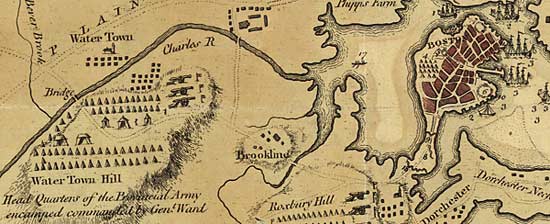Background to the war
Major General William Howe, Major General Henry Clinton and Lieutenant General John Burgoyne arrived in Boston, Massachussetts, aboard the frigate H.M.S. Cerebus at the end of May 1775. They found that the British garrison of 6,500 men under General Thomas Gage had been besieged in the town since the 19th of April following the latter's attempt to arrest a number of Americans and destroy arms and ammunition at Lexington and Concord. The wits of Boston pursued the three new Generals with the rhyme:
The Cerebus furrows the ocean like a plough
It bears Burgoyne, Clinton and Howe
Bow, Wow, Wow

Detail from 'A plan of the town and harbour of Boston [...] shewing the place of the late engagement between the King's troops & the provincials, together with the several encampments of both armies in & about Boston', 1775
By permission: Library of Congress, Geography and Map Division
Relations between Britain and her American colonies had been deteriorating for a number of years, but even so it came as something of a shock to Sir Henry to realise that the situation would have to be resolved by war. In a letter to his friend Charles Mellish later that summer he wrote, "you know how much I wished for peace, how desirous I was to do everything to preserve it, what romantick notions I had even if pushed to extremity to try everything before blood was drawn"
Sir Henry was clearly no firebrand and hoped throughout much of the summer of 1775 that the rebellion in New England (as he saw it) was a comparatively isolated event. It was only in the autumn of that year that the British military command began to realise the enormity and severity of their task.
Next page: The people involved